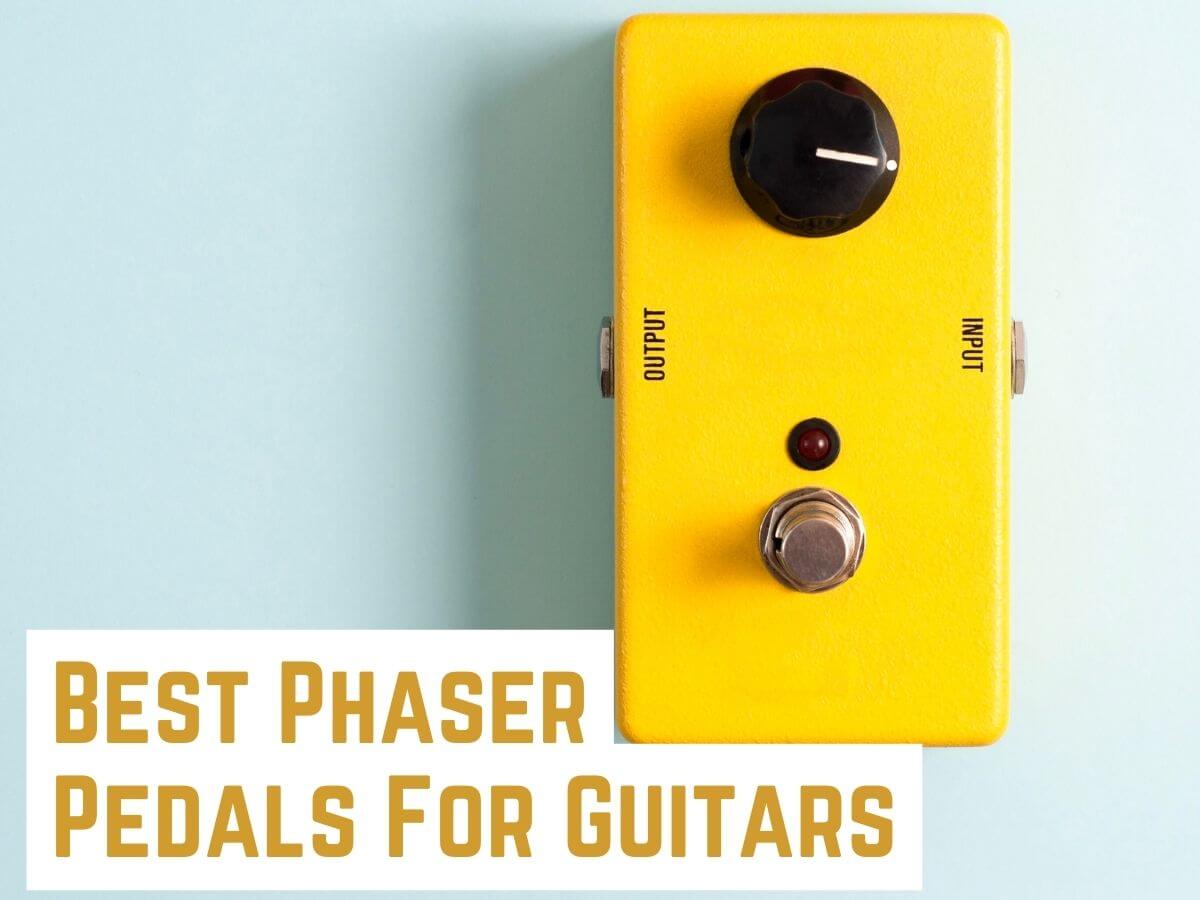
Phaser pedals are one of the most popular modulation effect pedals, used by legends like Jimi Hendrix and Eddie Van Halen in many iconic songs. But there’s a lot of phaser pedals in the market now, so it can be confusing to know which one is best for you.
That’s why we’ve created this list of the 7 best phaser pedals that you can buy right now, along with some important tips on what to look out for.
What is the Best Phaser Pedal?
1. Walrus Audio Lillian Multi-Stage Analog Phaser Guitar Effects Pedal – Best Overall
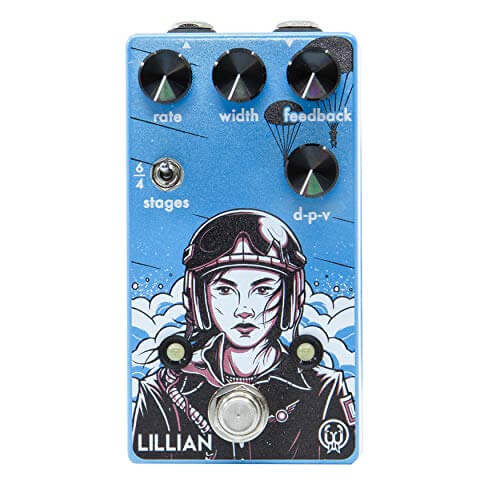
Specifications
- Controls: Rate, Width, Feedback, D-P-V, Stages Switch
- Bypass: True
- Power: 9V PSU
Walrus Audio is a manufacturer of high-end, boutique effect pedals, and though they are quite new, they’ve already garnered a lot of attention for their innovative and artistic designs. The Walrus Audio Lillian is a multi-stage analog phaser with a lot of features and a wide variety of tones available for tinkering around with.
The Lillian has 4 control knobs on top for Rate (speed of the LFO), Width (frequency range of the LFO), Feedback (amount of signal going back into the phaser), and D-P-V (dry, phaser, vibrato). The D-P-V control is particularly interesting, as it allows you to mix between a dry sound and a full-on pitch vibrato tone, and anything in between. There’s also a switch that toggles between 4 stage phasing for a tighter sound, and 6 stages for a more layered and expressive tone. According to famous guitarist Pete Thorn :
There’s not many phasers I’ve tried that sound this deliciously analog/vibey!
The Lillian, inspired by WWII pilot Lillian Yonally, features a really cool artwork with an aesthetic design to it. It’s built with a sturdy aluminum chassis, and there are LEDs for power state indication. The footswitch has a true relay bypass, and it also has a non-latching, momentary function for adding expression to your performance. It requires a 9V power supply for operation.
If you’re looking for the best phaser pedal for guitar, then look no further than the Walrus Audio Lillian. With a slew of controls that offer in-depth customization, multi-stage analog phasing, a blend control, and beautiful artwork in a robust chassis, the Lillian is an exquisite addition to any guitarist’s pedalboard.
2. Joyo JF-06 Vintage Phase Guitar Pedal – Budget Pick
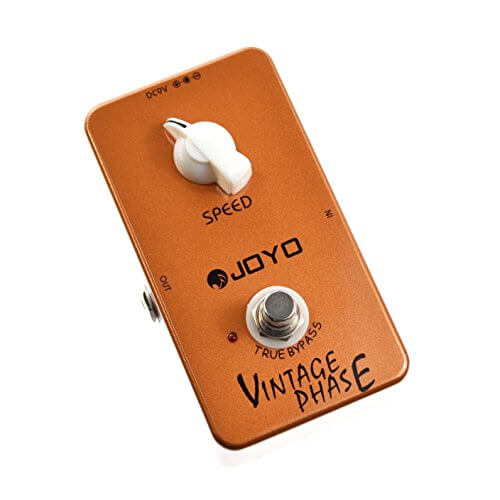
Specifications
- Controls: Speed
- Bypass: True
- Power: 9V PSU or Battery
Joyo has quickly gained a lot of popularity in the guitar community for producing good-quality effects pedals at very affordable prices. The Joyo JF-06 is another in their lineup, and is a vintage analog phaser designed to replicate the iconic tones of Eddie Van Halen as well as other innovative modulation sounds.
The JF-06 has just one big central knob for adjusting the ‘Speed’ of the low-frequency oscillator. This allows you to go from a minimum of very slow and heavy-sounding phasers to Leslie-style, almost-vibrato tones with fast phaser effects. It’s a versatile knob, and when paired with overdrive and other effects in your pedalboard, it can lead to a variety of different tonalities. The phaser’s sound is reminiscent of vintage analog phasers used by Van Halen and others.
The Joyo JF-06 comes in an aluminum-alloy casing that’s very portable and would easily fit on any pedalboard. There’s true analog bypass here, which is surprising and uncommon at this price range. There are mono input and output jacks on the side, and it’s powered by either a 9V power supply or batteries, and there’s an LED to indicate the power state in dark areas.
If you’re looking for a budget option to achieve some classic analog phaser tones, then the Joyo JF-06 is one of the best options for you. With super-simple controls making it easy to dial in a great sound, a sturdy metal chassis, and true analog bypass, there’s more than enough here to satisfy most guitarists looking for a phaser pedal.
3. MXR M290 Phase 95 Mini Guitar Effects Pedal – Most Portable
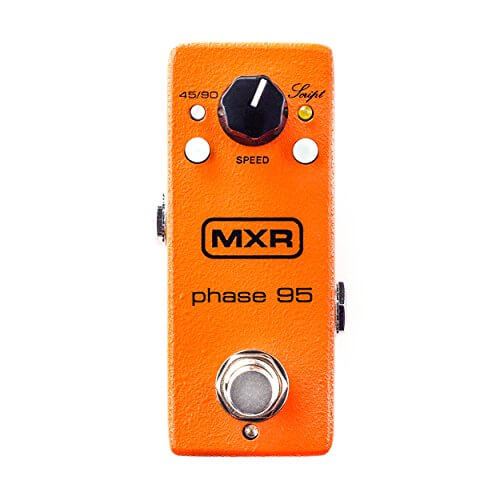
Specifications
- Controls: Speed, Script Switch, 45/90 Switch
- Bypass: True
- Power: 9V PSU
MXR, a Dunlop brand, has been producing high-quality effects pedals for decades now, and they have been used by many famous artists like Eddie Van Halen and Jimi Hendrix. The MXR M290 Phase 95, one of their newest releases, is a compact stompbox that features a lot of power in a single pedal, combining the power of their iconic phaser 90 and phaser 45 models in a miniature housing.
The MXR Phase 95 has one large central knob that controls Speed, much like the original phase 90, with button switches on the sides for Script, and 45/90 Mode. The Mode switch lets you choose between the phase 45 for a two-stage phaser with a smoother sound, and the phase 90 for a four-stage phaser for a more lush, vintage phase tone. The Script switch controls the feedback, for a more ‘swooshy’ sound with more effects, or for a more subdued phaser. According to Tom Quayle from Dawsons Music :
You’ve got the versatility of the Phase 45 and the Phase 90 in a tiny little housing, so it’s really a little powerhouse.
The Speed knob goes from a slow, pulsating vibe to fast, vibrato-style tones. All this versatility is packed into a very small pedal that’s built with robust aluminum and would easily survive a lot of rough usage. There are LEDs to indicate the modes, as well as one for the power state, and the pedal has true analog bypass. It’s powered by a 9V power supply.
If you’re looking for a really compact phaser pedal with a lot of versatility in it, then you should definitely go for the MXR M290 Phase 95 pedal. With two modes reproducing the iconic tones of the phase 90 and phase 45, a new Script switch, easy-to-use controls, and a miniature yet durable housing, the MXR Phase 95 can find its place on any pedalboard.
4. Electro-Harmonix Nano Small Stone Phase Shifter Pedal
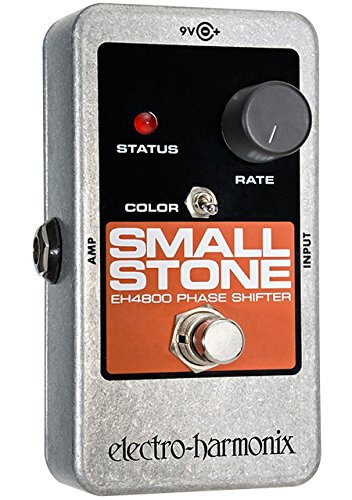
Specifications
- Controls: Rate, Color Switch
- Bypass: True
- Power: 9V PSU or Battery
Electro-Harmonix is a well-known name in the guitar community, and they produce some of the best effects pedals in the industry. The original Electro-Harmonix Small Stone was a classic hit in the ‘70s, used by famous artists like David Gilmour and Slipknot, and now it’s been made smaller with new artwork, but still with the same iconic sound.
The Nano Small Stone features just one knob that controls the Rate of the phaser effect, from a slow wobble, up to fast, pitch-vibrato tones. There’s also a Color switch, which can be used to give the pedal a more ‘hollowed-out’ tone, or leave it off for a full-bodied, classic phaser sound. But surprisingly, the Nano Small Stone is a very versatile pedal, suiting many genres from country music to rock and metal effortlessly.
The new Small Stone variant comes in a much sleeker and more aesthetic design, with a graphic design on top of a black-powdered enclosure. It’s built with aluminum for a robust and durable chassis, and it can easily fit more pedalboards due to its reduced size. It comes with an LED indicator, true analog bypass, and it’s powered by a 9V power supply unit or battery.
If you’re looking for a great analog phaser with a lot of portability, you should definitely check out the Electro-Harmonix Nano Small Stone. With iconic tone reproduction similar to the likes of Radiohead, versatile controls, cool artwork, and a compact form-factor, the Nano Small Stone is everything its predecessor was, and more, in a smaller package.
5. BOSS PH-3 Phase Shifter Guitar Pedal
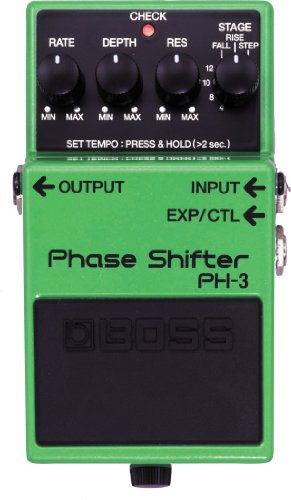
Specifications
- Controls: Rate, Depth, Resonance, Stage
- Bypass: Buffered
- Power: 9V PSU
Boss is one of the world’s most popular manufacturers of effects pedals, and their phaser pedals have been iconic as well. The Boss PH-3 is a blast from the past, providing iconic analog phaser tones in a classic Boss stompbox, but with added new features and more versatility, including multi-stage phasing.
The PH-3 has 4 knobs that control Rate (speed of the phaser), Depth (intensity of the phaser), Resonance (feedback), and a Stage control that lets you choose between various modes: 4, 8, 10, 12, Step, Rise, and Fall. These give you a great deal of versatility, and the new Rise and Fall modes are especially innovative, allowing you to create some inventive new soundscapes. You can even use external expression pedals to control parameters, as well as to tap the exact tempo.
The PH-3 comes in a classic Boss stompbox, with a bright green design and a big footswitch for easy access. It’ll easily fit in most pedalboards, especially those designed by Boss. It has an LED for power state indication, features buffered bypass to maintain signal consistency, and it may be powered by a 9V power supply or batteries.
If you’re looking for a great analog phaser similar to iconic vintage models, then you should certainly look at the Boss PH-3 Phase Shifter. With 4 knobs to fine-tune your sound precisely, innovative new phaser modes, a classic design, and external expression control, almost any guitarist would be able to find their sound with the PH-3.
6. TC Electronic Helix Phaser Pedal
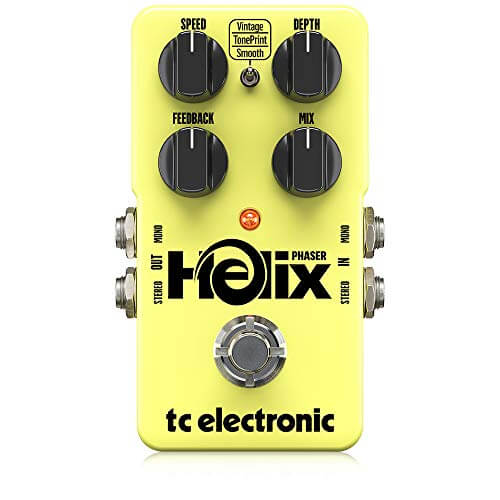
Specifications
- Controls: Speed, Depth, Feedback, Mix, Mode Switch
- Bypass: True or Buffered
- Power: 9V PSU
TC Electronic has become synonymous with high-quality effects pedals that have innovative new features. The original TC Electronic phaser pedal from 1976 had achieved legendary status, and now they’ve launched the Helix phaser to recreate those iconic tones while bringing modern versatility and user-friendliness to it in a more compact form factor.
The TC Electronic Helix phaser pedal comes with four knobs that control Speed, Depth, Feedback, and Mix. This is one of the more versatile phaser pedals listed here, giving you full hands-on control and letting you change almost every aspect of it. The mode switch toggles between three options: Vintage, Smooth, and TonePrint. Vintage offers a gritty, shimmery sound similar to a phase 90, while Smooth is much more rounded, suitable for modern music.
The Helix phaser’s real power lies in its TonePrint editor, which lets you connect to a Mac or Windows computer and adjust the intricacies of the tone, even letting you download other artist presets from online. TC Electronic offers custom artist presets from many famous guitarists like Scott Ian and Pete Thorn as well, and the ability to create your own tone here is unmatched.
The Helix comes in a standard TC Electronic stompbox, with a durable metal chassis and a standard size to fit in most pedalboards. There are stereo inputs and outputs here, as well as analog-dry-through, providing you with pure guitar tone goodness. The bypass is switchable between buffered and true, and it’s powered by a 9V power supply with a 100mA current draw.
If you’re looking for a really versatile phaser pedal that lets you create your own tones very easily, you definitely can’t go wrong with the TC Electronic Helix phaser pedal. With 3 different modes to toggle between that includes their proprietary TonePrints, versatile control knobs, a sturdy and compact design, and stereo I/O, the Helix is an amazing tool for both live performances and studio recordings.
7. MXR EVH90 Phase 90
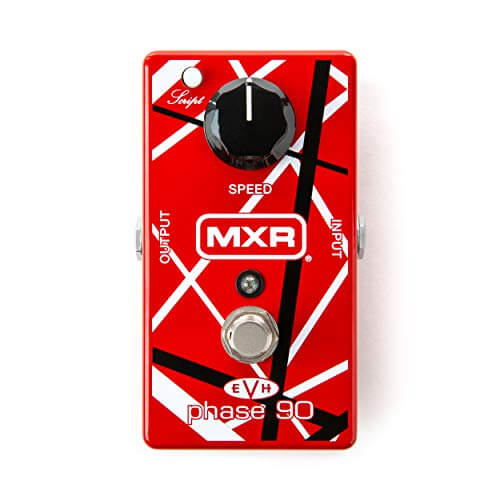
Specifications
- Controls: Speed, Script Button
- Bypass: True
- Power: 9V PSU or Batteries
The second pedal on this list by MXR, the EVH90 Phase 90 pedal is a special incarnation of the original MXR Phase 90, built specifically in collaboration with Eddie Van Halen to reproduce his iconic tones. It features a toggle button for two modes, and the classic ‘Frankenstein’ paint job that Van Halen had on his guitar to give you those classic vibes.
The MXR Phase 90 EVH90 has just one large central knob that controls the Speed, much like its predecessor, but it also has a small button that switches between ‘Script’ mode and ‘Block’ mode. The Script mode offers that vintage tone with more aggression and grit, whereas the ‘Block mode has a smoother, more rounded tone that’s suitable for modern music. The Speed knob goes from pulsating vibes to fast, original Phase 90 style pitch-vibrato phaser tones.
The MXR Phase 90 comes in a very compact and durable metal stompbox, with a classic ‘Frankenstein’ paint job that has red, white, and black stripes, much like Van Halen’s signature guitar. There’s a blue LED for power indication, and the bypass is true hardwired. It may be powered by a 9V power supply or by a single battery.
If you’re looking for those iconic Van Halen tones produced by the original Phase 90, then there’s no better way to achieve them than this signature pedal, the MXR EVH90 Phase 90. With a nostalgic paint job that looks fantastic, vintage analog phaser tones, two modes for versatility, and a portable form factor, the EVH90 Phase 90 is a pristine reincarnation of one of the best phaser pedals in history.
What To Know Before Buying a Phaser Pedal?
If you’re still not sure about which phaser pedal is right for your pedalboard, then here are some important things to keep in mind:
Sound Signature
Phaser pedals offer a wide range of sounds, from smooth and rounded, to gritty and choppy, and with different ranges of rates and intensities. Some might have just one mode, while others may have multiple modes and toggle switches to choose from, giving you a lot more versatility.
The main differences in phaser pedals often arise from the type of low-frequency oscillator (LFO) used, and the waveform produced by them. There are also other variations amongst phaser pedals; some have analog circuitry while others have digital circuitry.
Analog pedals offer more authentic vintage phase sounds, whereas digital ones offer modern flexibility.
Hence, you should go for a phaser pedal that offers the exact tones you need, whether you want a flexible pedal that may have digital circuitry, or a simpler, analog one with more authentic, classic phaser sounds.
Controls And Power Requirements
Phaser pedals come with a wide range of controls, with some having only a single knob while others have 3 or even 4 knobs as well as toggle switches for different modes and functions.
The standard control options commonly found on a phaser pedal generally consist of just a Rate, or Speed knob, such as on the MXR Phase 90, but some offer other controls wet/dry mix (or blend), feedback, depth (intensity of the phaser), tap tempo, etc. Depending on how you want to use a phaser, and whether you want to customize your sound in-depth, or just plug-and-play with one knob, you should opt for a comfortable pedal for you to use.
The power requirements of a phaser pedal are also a major consideration. Some phaser pedals can be powered by 9V batteries, which is great for portable, on-the-go usage, but some of them require a 9V DC power supply unit and have a higher current draw.
Hence, depending on your usage cases (studio, live, or home use), your pedalboard’s design, your power brick, etc., you should pick a phaser pedal that will easily fit into your current pedalboard and also get enough power to run smoothly and noiselessly.
Bypass Type
Pedals with buffered bypass convert your signal from high impedance to low impedance, and then amplify it again to prevent any loss in signal strength while it flows through the pedal’s circuitry. This ensures a stable, consistent signal throughout your pedalboard. However, the problem arises when the buffer used is of low-quality (often found in cheaper pedals), which causes a sharp loss in brightness and integrity of the guitar sound (also known as ‘tone-sucking’) .
In true-bypass pedals, your guitar’s signal is routed directly through the pedal circuitry without any alteration.
True bypass usually works best when you’re only using a couple of pedals and short cables. But adding more true bypass pedals means more cables, and that will result in a loss of brightness and treble along the signal chain, so you have to be careful about that.
Hence, depending on your pedalboard size and the length of your overall signal chain, different bypass modes may be required in different circumstances.
FAQs
What does a phaser guitar pedal do?
A phaser pedal uses a low-frequency oscillator (LFO) to create a modulation effect, where it mixes two signals: a processed signal and an unprocessed signal. The processed signal is slightly delayed, and also passed through certain filters in a rhythmic manner (determined by the speed of the LFO). When this is mixed with your dry signal, it produces an ‘out-of-phase’ effect, which gives it the signature ‘swoosh’ sound, and adds a lot of texture as well.
Where should I put my phaser pedal?
You should put your phaser pedal at the end of your signal chain, much like other modulation effects. It should be after any overdrive or distortion pedals, and before any time-based pedals like delay or reverb, and can be placed alongside your tremolo and chorus pedals. But if you’d like to experiment, you can place it in different positions and see how it affects your sound.
What is the difference between a flanger and a phaser?
A flanger and a phaser are both modulation effects that use an LFO and may often seem quite similar, but the difference between them lies in the way the signals are processed and filtered. Phasers use an ‘all-pass filter’ to filter the signal waveform in specific places, then an LFO delays the signal and places it on top of the dry signal. In a flanger, however, the delay time is shorter, and the filter used is a ‘comb filter’, resulting in more feedback.
